Switzerland and Cameroon squared off in Group G’s first encounter in the World Cup. The other two in the group, Brazil and Serbia, seem to be a challenge for both the Swiss and the Cameroonians. The team Switzerland was led by Murat Yakin, a Swiss coach himself and Cameroon by Rigobert Song, also a Cameroonian who was known for his defensive skills. Even though Cameroon’s tactics often worked, Switzerland had quality players overall which resulted in securing the win by one goal.
This tactical analysis will look at how Switzerland was able to survive Cameroon’s threats and secure the win in Group G’s opener. We will also look closely at all the tactics used by both teams in addition to statistics.
Lineups
Rigobert Song had a competitive squad to work his tactics. He went with 4-1-4-1 which he mostly favours playing. André Onana the pillar of Ajax a few years ago, started between the posts. Jean-Charles Castelletto who currently plays for Nantes was accompanied by the 32-year-old Nicolas Nkoulou who plays in the Greek league to form the central defence. Collins Fai, the right-back plays in Saudi Arabia’s first tier and the left-back, Nouhou Tolo of Seattle Sounders. The defence seemed to be good to compete against the Swiss.
The midfield rather was better which featured André-Frank Zambo Anguissa from Napoli who has been shining recently. He played in the right midfield position. Samuel Oum Gouet, playing in the Belgian league was played as the central midfielder and on the left played, Martin Hongla the 24-year-old from Hellas Verona. The above three were led by the team captain Eric Maxim Choupo-Moting, the star from Bayern Munich. In the right wing was Bryan Mbeumo from Brentford, just 23 years of age with left-foot flair and in the left wing was Karl Toko Ekambi from Olympique Lyonnais.
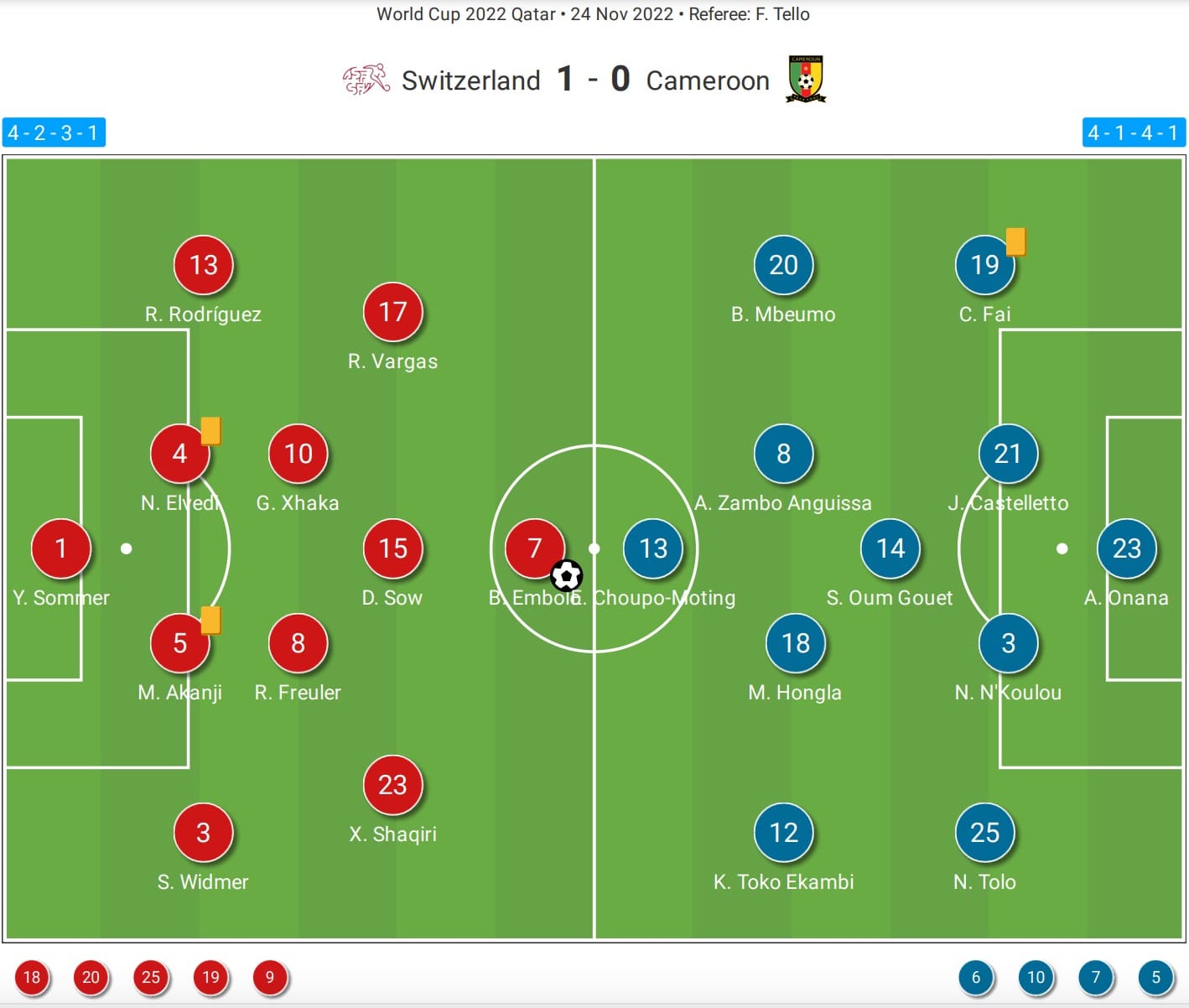
Murat Yakin selected an experienced group of players to play in Qatar. Yakin after trying to experiment with a new formation, the team saw a loss against Ghana in their friendlies just before the World Cup. Thus, he stuck to his ideal formation 4-2-3-1 with Yann Sommer from Borussia Mönchengladbach, in the goal as predicted. Manuel Akanji from Manchester City paired with Nico Elvedi from Mönchengladbach to form the central defence. Silvan Widmer from Mainz 05 played as the right-back and Ricardo Rodríguez played in the right-back position while playing his 4th World Cup for Switzerland.
Granit Xhaka, the Arsenal star and the team captain sided with Remo Freuler from Nottingham Forrest and played as the double pivot in the midfield. Xherdan Shaqiri played in his favourite right side which is also his 4th World Cup and 7th major tournament for Switzerland. Ruben Vargas, the 24-year-old was placed in his favourite left side and Djibril Sow of Eintracht Frankfurt played as the centre attacking midfielder. Breel Embolo from Monaco, who’s known for his pace played as the centre-forward for Switzerland. Both the teams were pretty matched throughout the game.
Switzerland utilised all 5 substitutions for the first time in the World Cup whereas Cameroon used only 4. Fabian Frei, Haris Seferović and Noah Okafor all three came on for Sow, Shaqiri and Embolo in the 72nd minute. Fabian Rieder and Eray Ervin Cömert came on late in the game for Vargas and Rodríguez. Gaël Ondoua and Georges-Kevin replaced Hongla and Toko Ekambi in the midfield and Choupo-Moting and Mbeumo were replaced by Nicolas Moumi Ngamaleu and Vincent Paté Aboubakar up front.
Switzerland’s changeover
Switzerland’s attacking plan was revised in the second half, which proved important in creating chances like no other. In contrast to the first half, every player felt at ease in their designated position. They were able to create space in the second half, which led to important passes. The diagram below depicts how Switzerland was able to modify its structure to discover passageways in half-space. Freuler and Xhaka have surged up the pitch, while offensive midfielder Sow has dropped back to pull the defence.
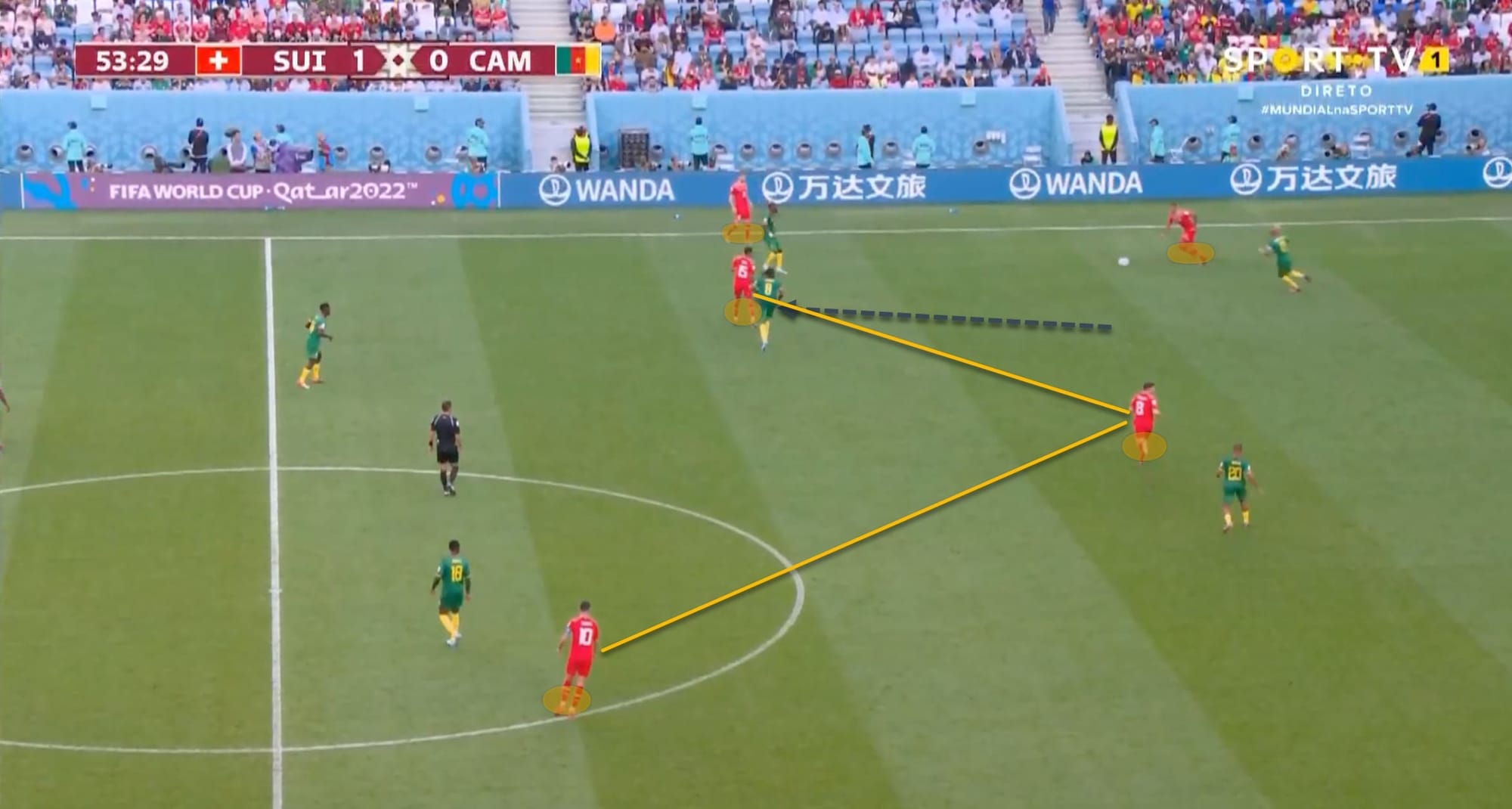
They were able to quickly collapse the front-man press, resulting in the final third build-up. Freuler was crucial in teaming with Xhaka to generate balance in the centre. Switzerland’s important opportunities were made possible by Shaqiri’s shaky foot crossing. Shaqiri nearly supplied another similar assist, this time a quick low-cross to the centre of the penalty box, but Vargas’ shot was saved by Onana.
Freuler and Sow were both extremely well situated in the second half, pulling opponents to create space. Xhaka often went forward on counter-attacks to help the front four. Freuler remained on the pitch to rebalance the midfield line. The diagram below shows how Switzerland may land in an excellent crossing position to attack Cameroon’s defences.
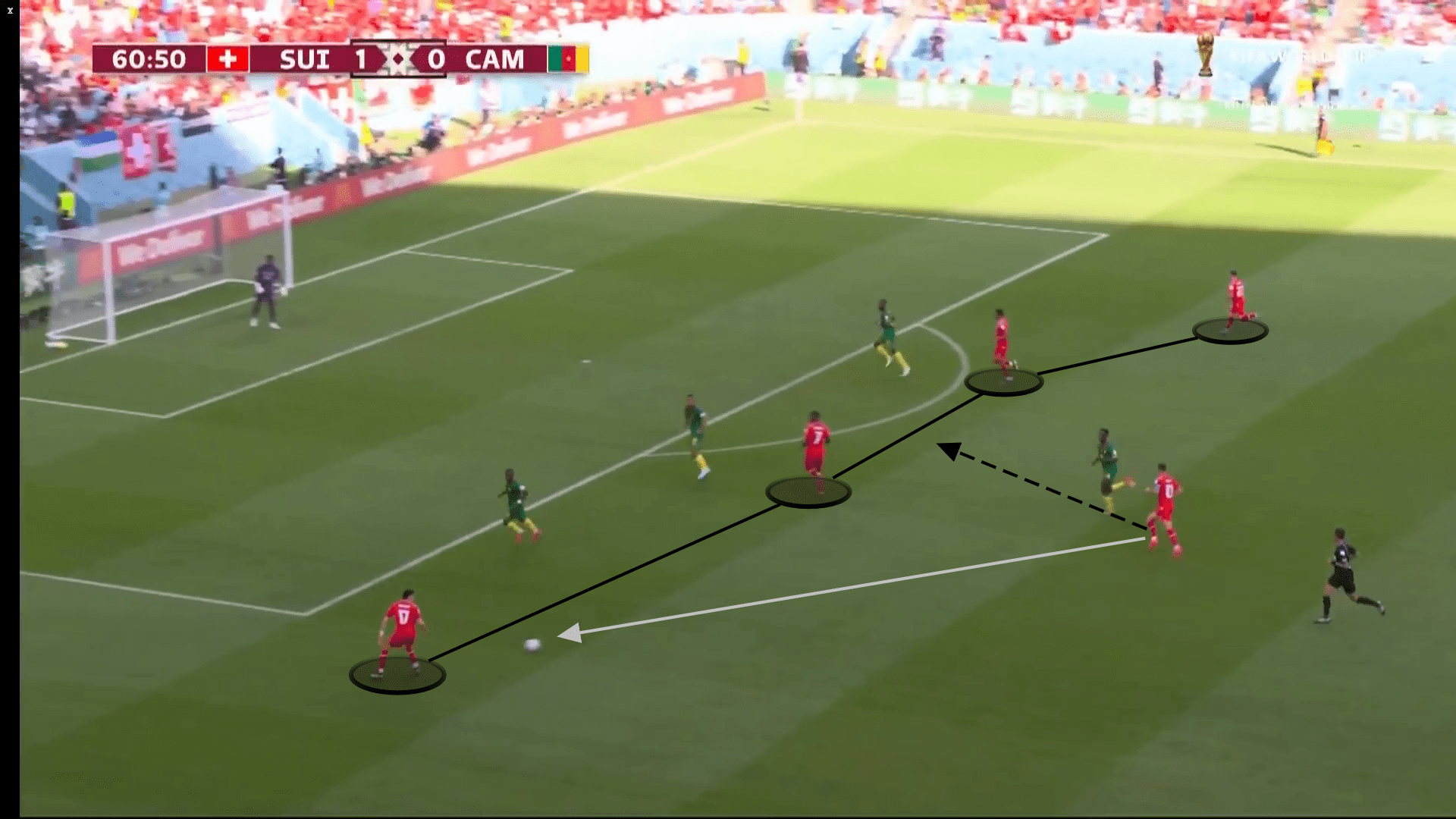
In the above image, Vargas, Embolo, Sow, and Shaqiri are the front four, with Sow joining the front three. Cameroon’s defence faced a 4v3 situation. Xhaka would go to the box on occasion to place an additional guy inside. This counter-attacking, along with crosses, was critical in rattling Cameroon’s defence and securing the victory.
Vargas and Shaqiri made sure to deliver dangerous balls to Embolo, who is a poacher in front of the goal, with several efforts on crosses from the sides. The graph below depicts the winger’s activities during the game. Even though the number of precise crosses was low, they produced the greatest goal-scoring opportunities for the Swiss.
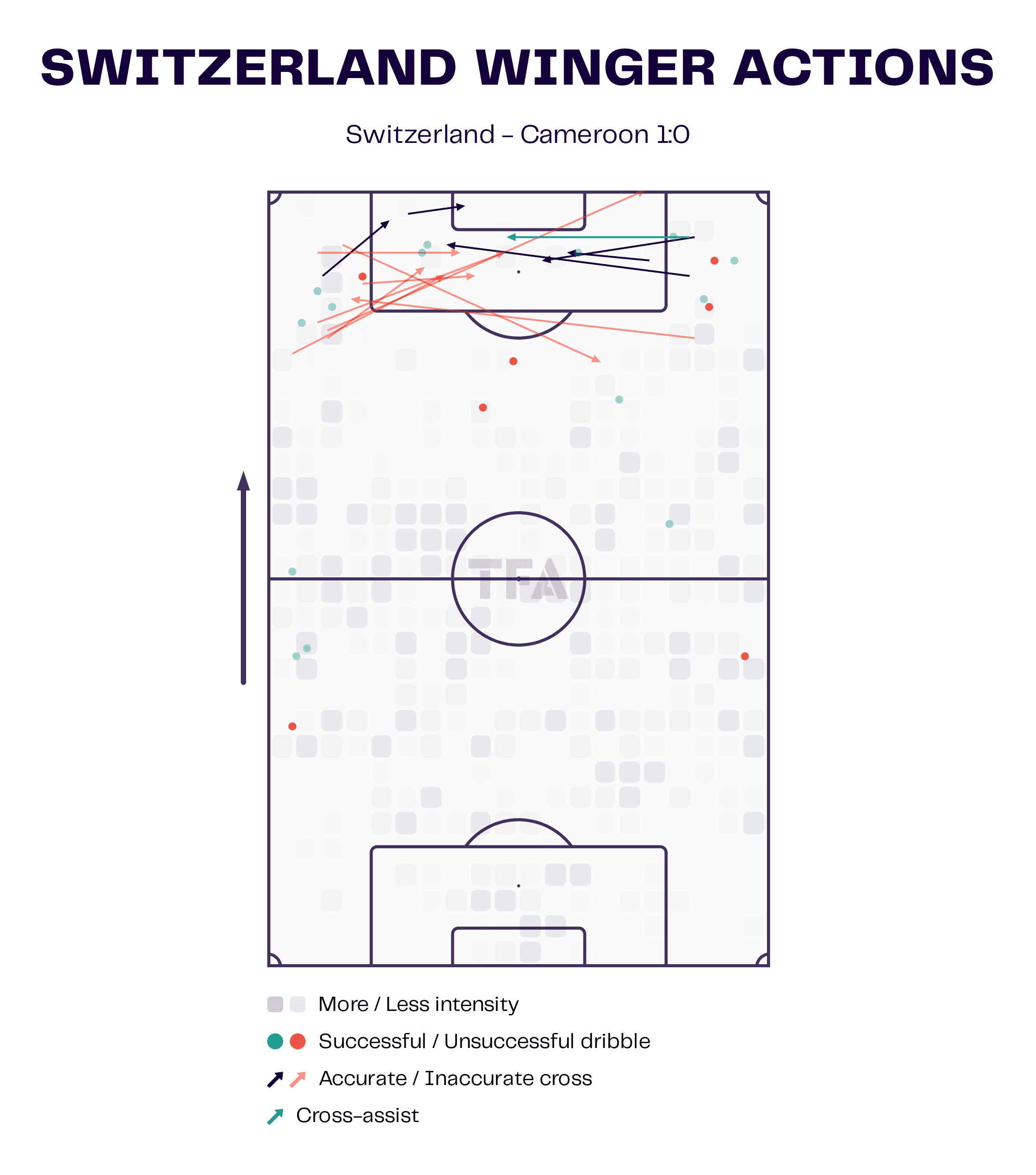
The number of carries by the wingers and the midfielders unleashed the Swiss’ performances. In the below image, Switzerland has an astonishing 23 penetrating carries into the penalty area. Vargas on the left and Shaqiri on the right gave the flexibility to stretch Cameroon’s defence. Sow was in the exact position he wanted to be in to join the front three as well to meet the incoming balls from the flanks.
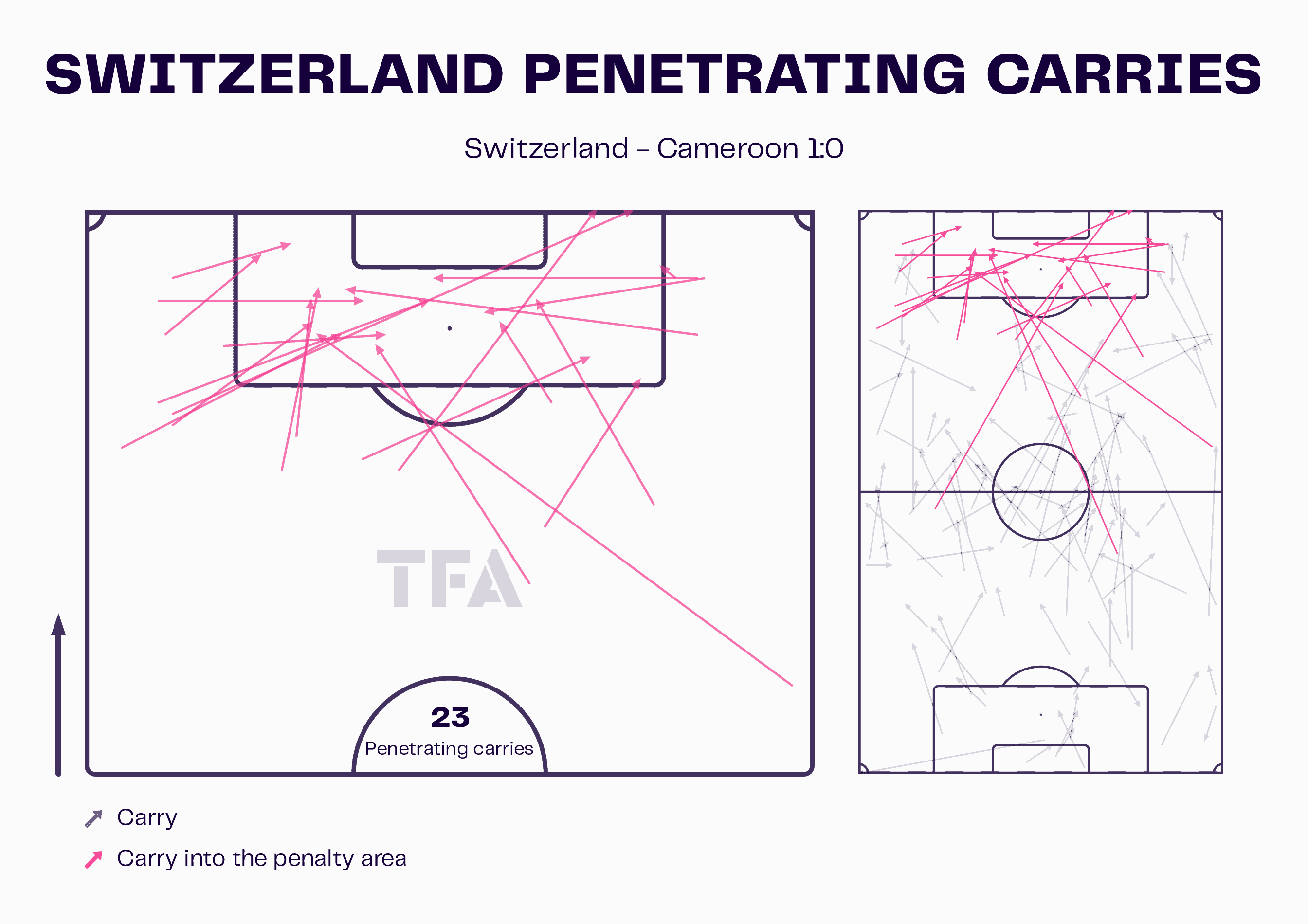
Although Akanji nearly scored from a corner just before the end of the first half, Cameroon had 3 shots on target with 5 shots in total, whereas Switzerland had all 3 shots off target. At the end of the match, it was pretty much equal but Cameroon had 2 more shots on target than the Swiss, which makes it 5 total shots on target and 8 in total. Switzerland could only make it 3 on target, all of those coming from crosses with 7 shots in total.
Cameroon’s counter threats
Cameroon caught the Swiss defence off guard on several occasions. Mbeumo’s tight control dribbling caught the defence off guard right beyond the box. In the final third, he was able to break through the defence with a handful of pass combinations.
Switzerland seemed to have solid ball possession in the first half and offered a threat at times, but Cameroon’s counterattacks provided a considerably larger threat. The Swiss players were concerned about Mbeumo’s left foot and Choupo-fast Moting’s feet near the box. Throughout the final third build-up, Cameroon threatened to create opportunities with their slick connections. Cameroon seemed to be the fans’ favourite to win the opening after they were able to keep the ball and appear to attack.
Toko Ekambi’s presence was noticed more on the sides than in the centre of the field, and he actively engaged in the game. Below is an example of how Cameroon calmly sliced open Switzerland’s press, resulting in a very great build-up but failing to capitalise. Cameroon seemed more dangerous than the Swiss at times.
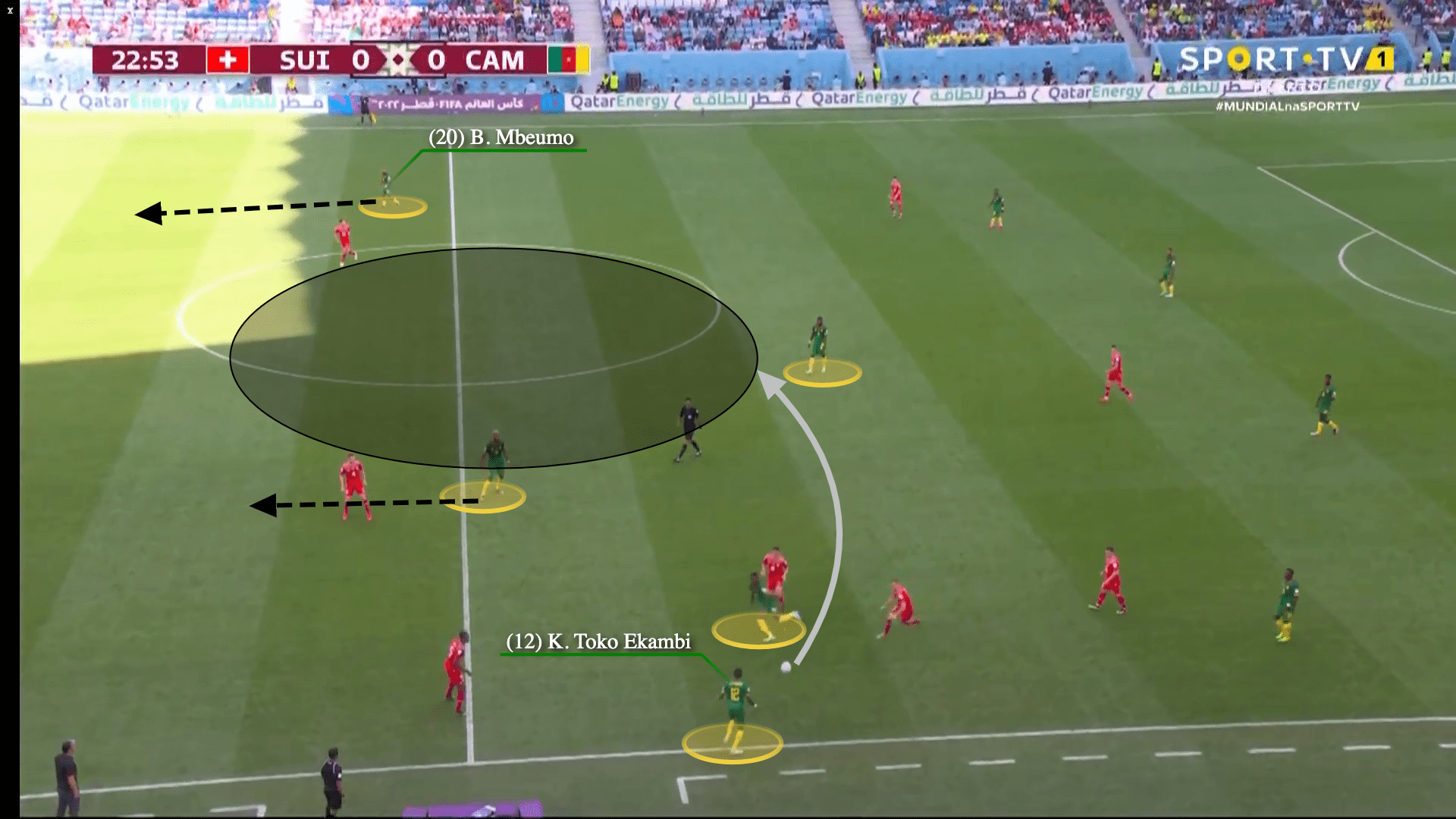
Toko Ekambi was highly effective in making vital passes to relieve pressure while developing up front in these tight areas. Choupo-Moting would then go further into the area as Mbeumo attempted to whip a cross or take a shot on goal. He started on the left wing but moved to midfield to gather and make a play.
Cameroon benefited from the presence of Napoli’s Zambo Anguissa and Hongla in the midfield. When Cameroon wanted to make a break, the two centre midfielders would move to the flanks to combine with the full-back and the winger. Mbeumo lowers to provide room for the full-back and Hongla to progress up the field. The image below and above show the move with wingers dropping to midfield to create space up front.
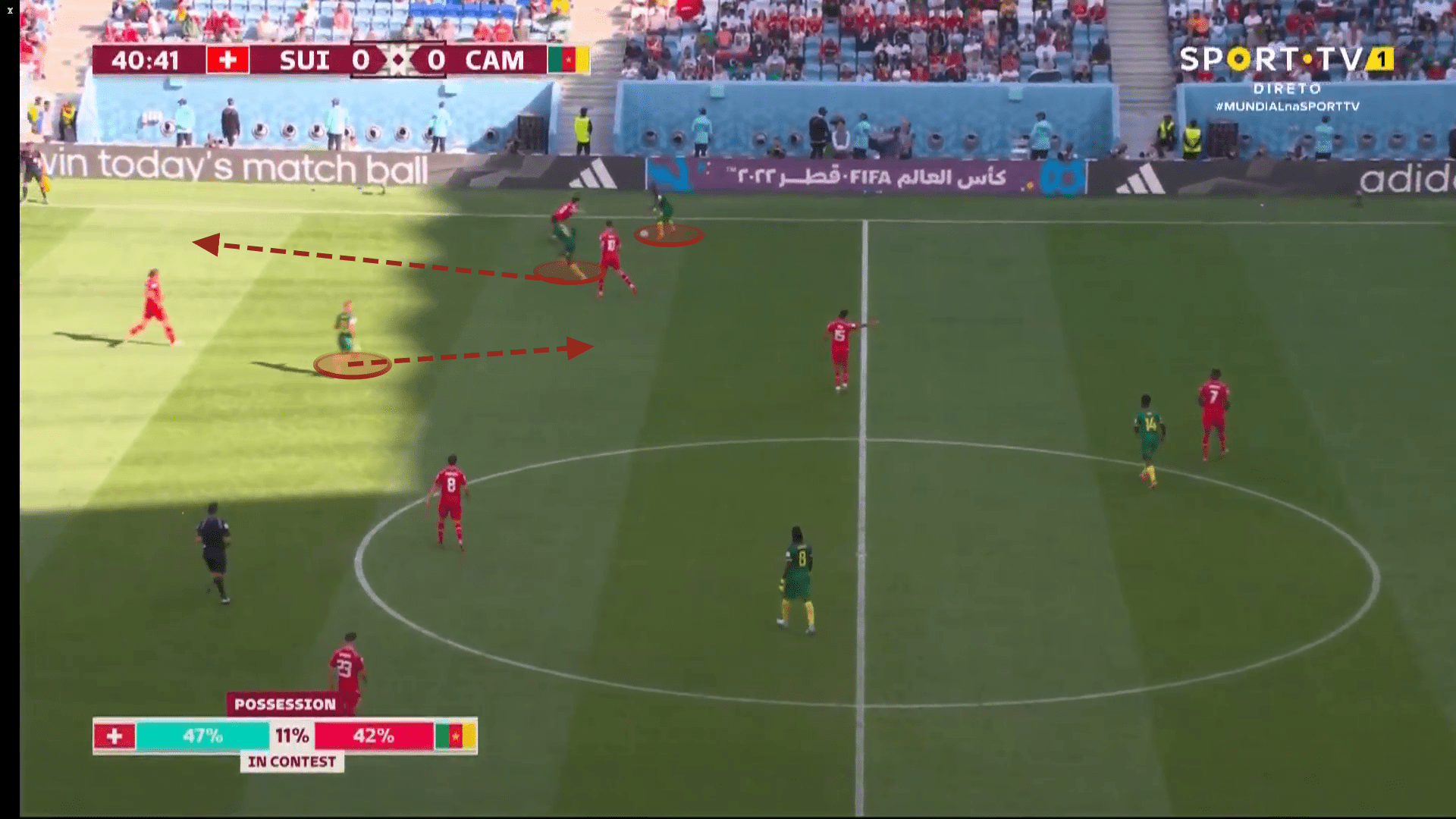
Choupo-Moting, of Bayer Munich, remains in the centre to serve as a link between the two sides. Cameroon benefited from this in the majority of circumstances leading up to the final third. When Zambo Anguissa wins the ball in Cameroon’s penalty area, he often pushes up the field in search of help, particularly to the wings where there is space. One of the instances in which Anguissa’s ball-holding skills were evaluated is seen in the image below.
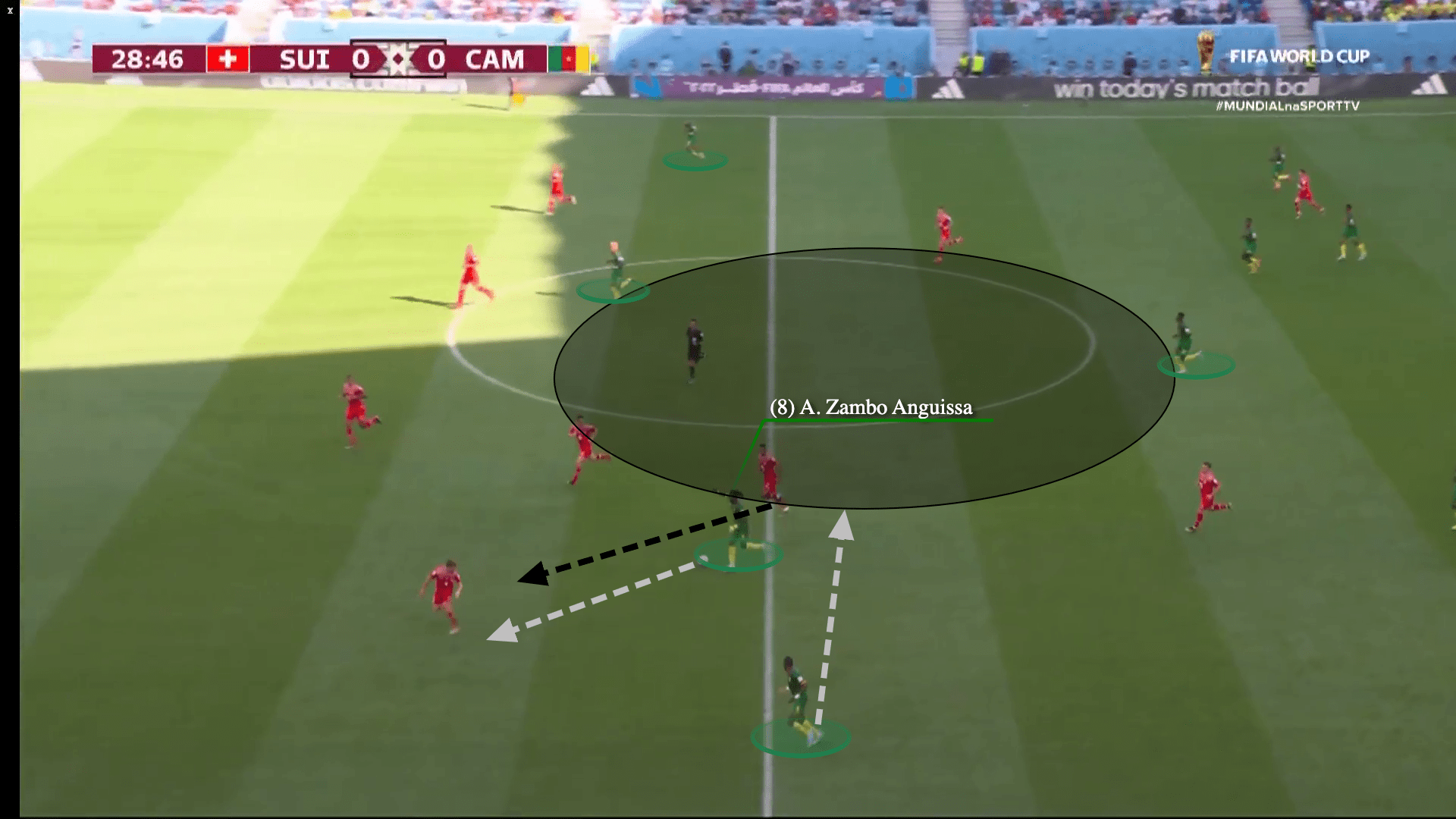
In the top image, Tolo, the left full-back, assists Anguissa as he drives up to the left side of the field from his penalty box, enabling Tolo to take advantage of the wide space in the centre with Oum Gouet racing parallel. As a result, Switzerland’s midfield crumbled, rendering them more susceptible.
After winning the battle, Onana decided to play long balls to the front rather than build up and finish in an overload. Cameroon dominated aerial duels, making them more comfortable. One example is seen here, where the Swiss full-back is in a 1v2 scenario with Tolo overlapping and Toko Ekambi attempting to make a run to meet the cross.
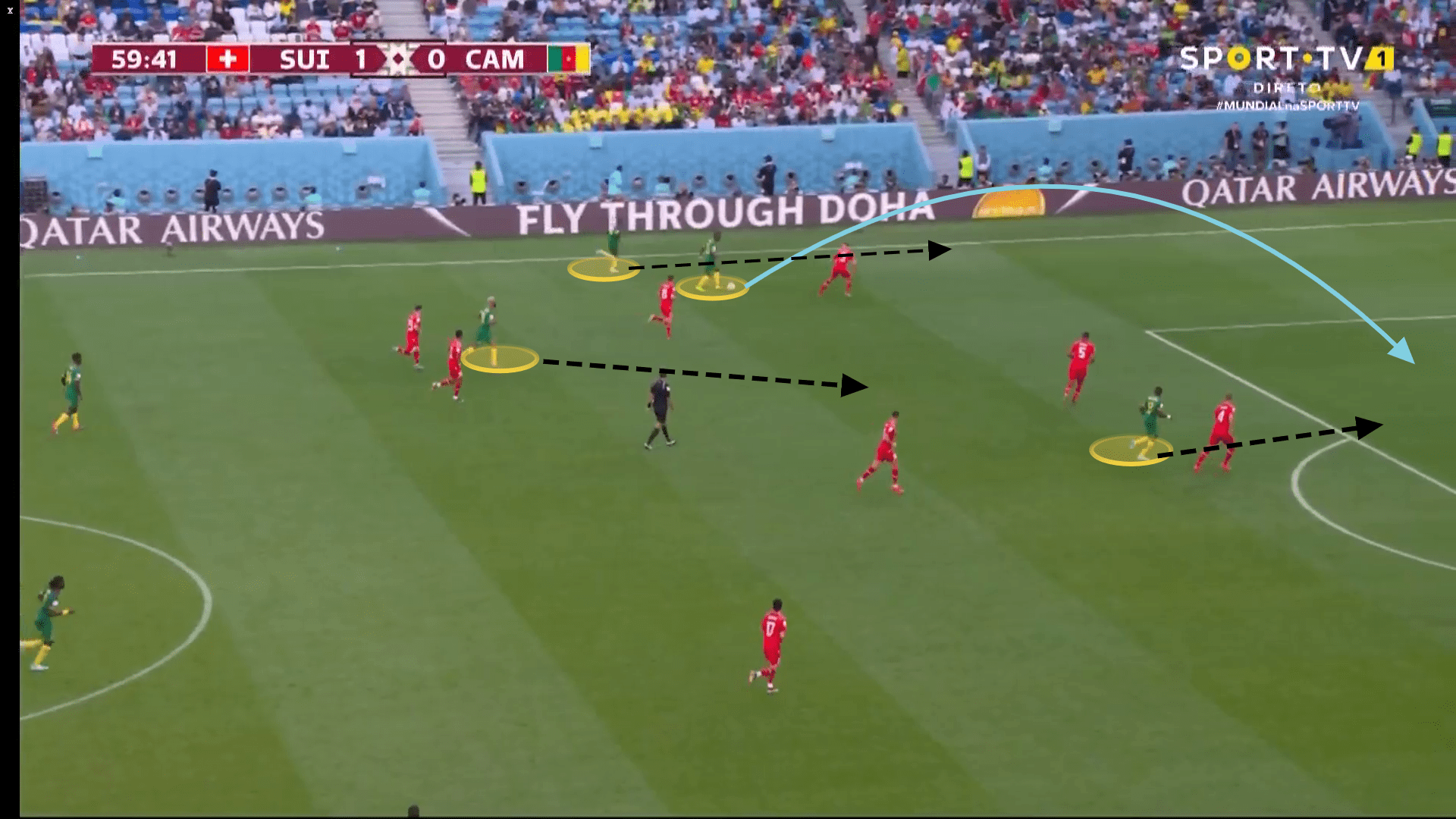
Because of Onana’s kick towards the right area, which resulted in an overload, the regains they made after the battle were enormous. Cameroon’s build-up was only visible in Switzerland’s half in the second half. Onana’s long-range kicks were crucial in winning duels and recovering possession of the ball in the opponent’s box. The graph below depicts the Cameroonians’ high regain throughout the encounter.
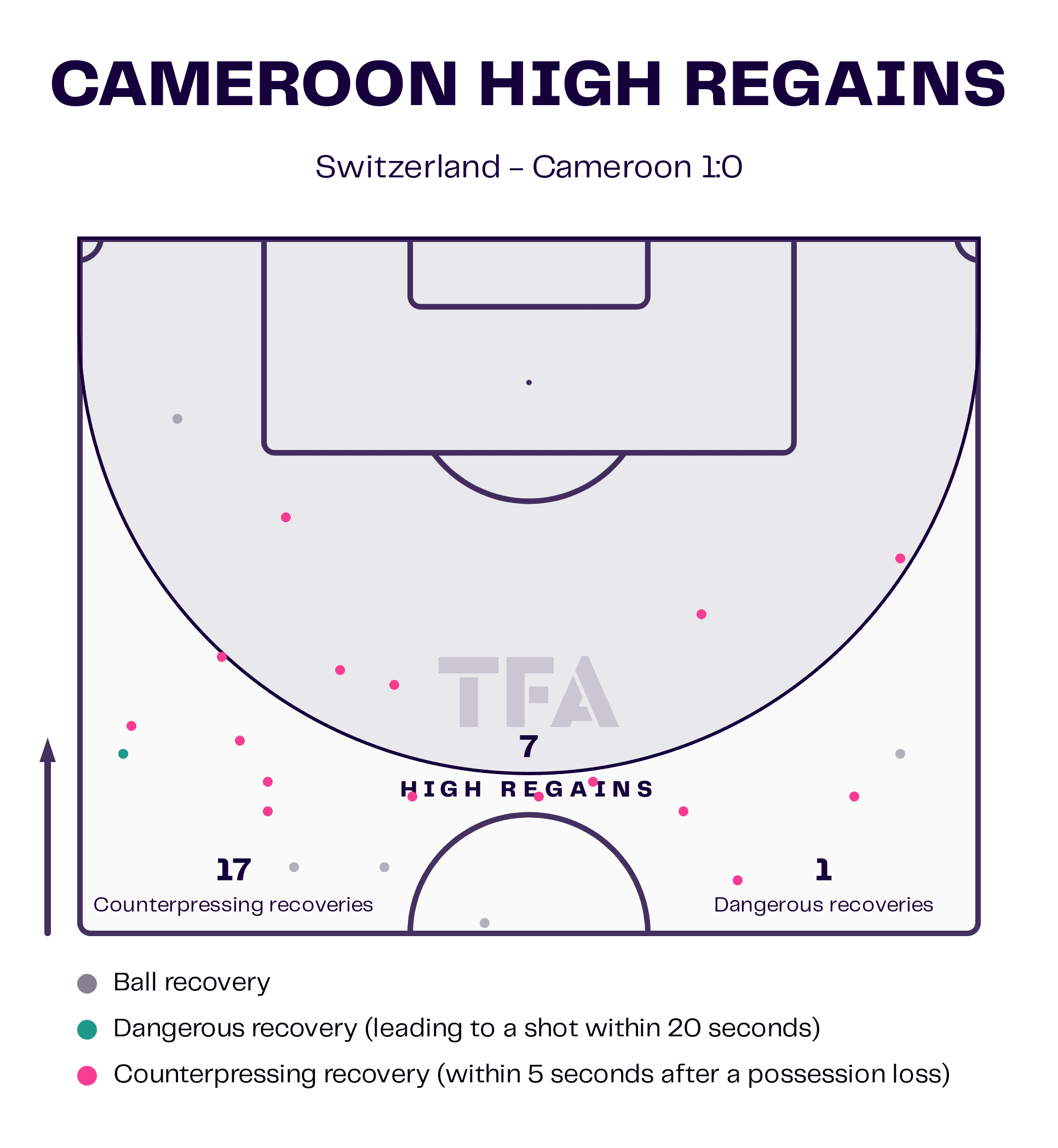
The following picture shows some great counter-pressing recoveries. Cameroon controlled the duels by regaining possession of the ball or overloading on one side. This is essentially how they got beyond the first and second presses.
Although Choupo-Moting took his time settling in, his enthusiasm and quick feet were unrivalled up front. He was able to initiate the press at the proper moment and win the press as a centre-forward. Despite holding the ball better than Cameroon, Switzerland was unable to win duels against the muscular Cameroonians. As a result, Cameroon won duels in the first and second thirds of the game.
Conclusion
Both sides were well matched in the battle, but it was Switzerland who triumphed by a single goal, while Cameroonians captured the hearts of the crowd with an outstanding performance. Individual brilliance from Switzerland’s Xhaka, Embolo, and Shaqiri put the squad ahead of the opponents.
Cameroon finished the game with 8 total shots and 5 on goal, whereas Switzerland only had 7 shots and 3 on goal. This illustrates that Switzerland was fortunate to score, whilst Cameroon was unlucky not to. In the second half, all of the essential players were in the right position at the right time and contributed heavily to the team. After Shaqiri’s spectacular low cross, Embolo placed the ball past Onana. He was born in Cameroon and scored the most ironic goal to open the World Cup.
The weakness of both teams shown in the analysis played a key role in dismantling both defences. Thus, Cameroon now has to win and draw against Serbia and Brazil to keep up its World Cup hopes.

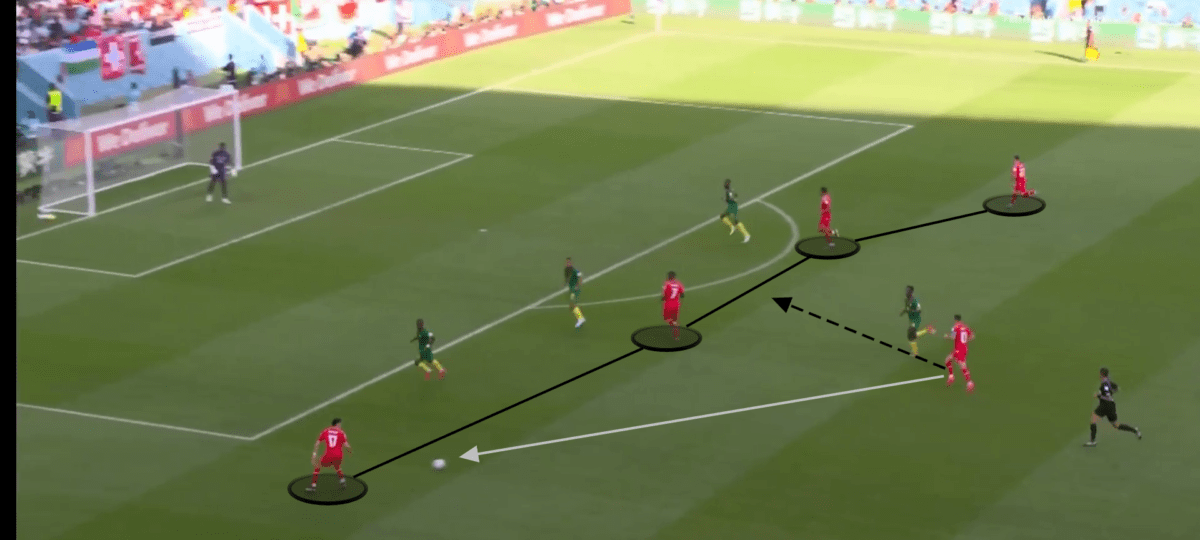
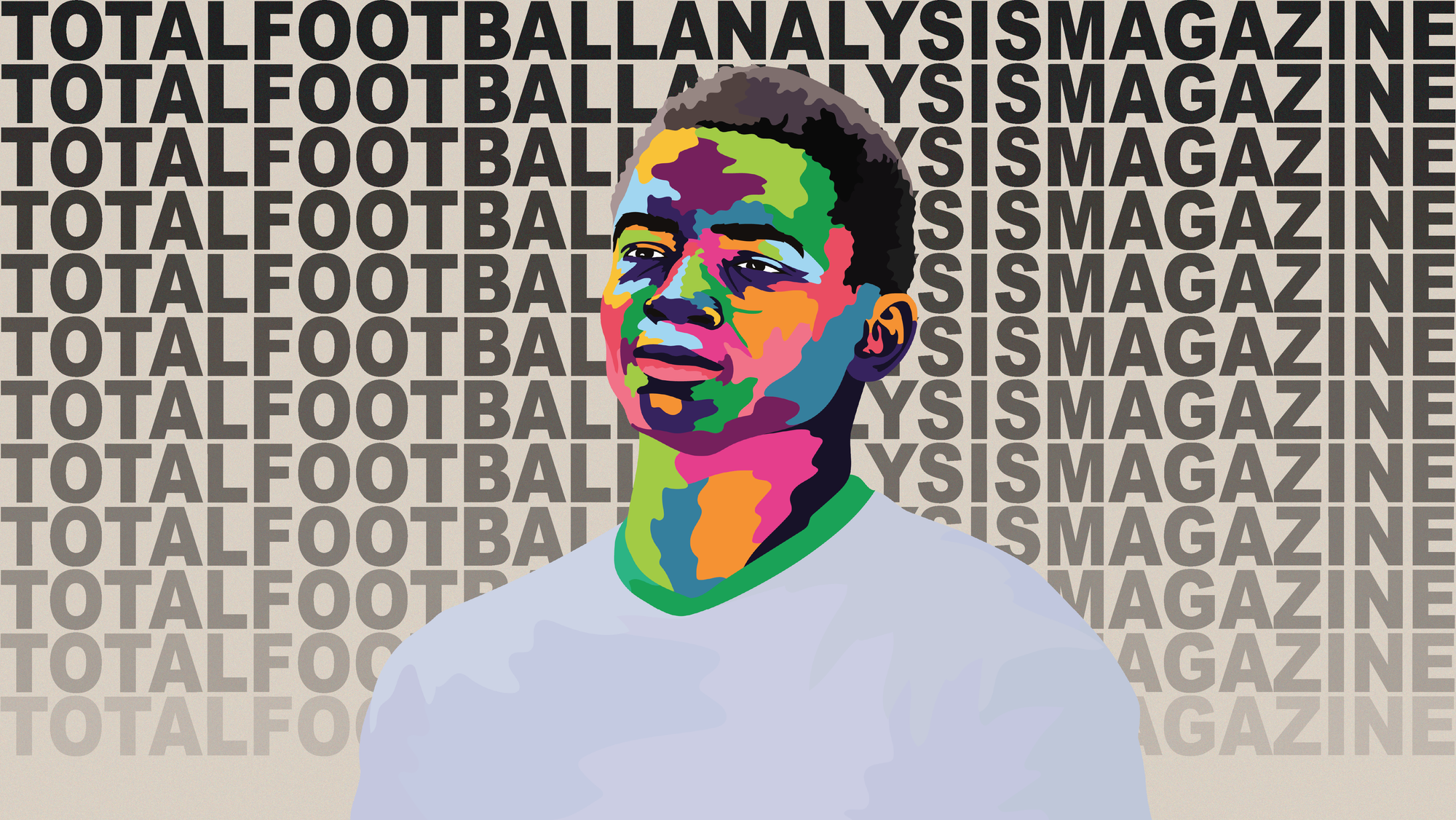


Comments